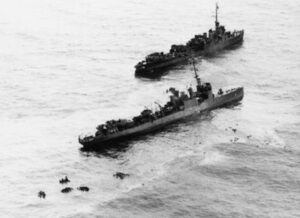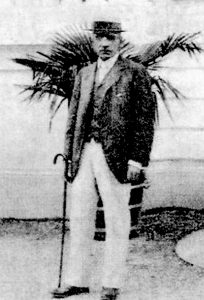boiler

 Quite likely one of the most brutal kinds of bombs was the mine. These mostly submerged orbs could take out an unsuspecting ship the minute it made contact with it, usually with no warning at all. So great was the danger to ships in the area, that the nations started building ships for the express purpose of seeking out these mines and destroying them before they were able to destroy a ship in the area. One such ship, the USS Perry was built by Mare Island Naval Shipyard at Mare Island. It was laid down September 15, 1920 and launched October 29, 1921. Named in honor of Oliver Hazard Perry and sponsored by Miss Anne R Scudder, it was commissioned August 7, 1922, with Lieutenant Richard H Booth in command, but it wasn’t initially designed to be a minesweeper.
Quite likely one of the most brutal kinds of bombs was the mine. These mostly submerged orbs could take out an unsuspecting ship the minute it made contact with it, usually with no warning at all. So great was the danger to ships in the area, that the nations started building ships for the express purpose of seeking out these mines and destroying them before they were able to destroy a ship in the area. One such ship, the USS Perry was built by Mare Island Naval Shipyard at Mare Island. It was laid down September 15, 1920 and launched October 29, 1921. Named in honor of Oliver Hazard Perry and sponsored by Miss Anne R Scudder, it was commissioned August 7, 1922, with Lieutenant Richard H Booth in command, but it wasn’t initially designed to be a minesweeper.
Nearly 20 years after the ship was commissioned, the ship was converted to a minesweeper and redesignated DMS-17 on November 19, 1940. This particular ship was the third of eight ships that would be named after Oliver Hazard Perry, which seems to me, rather unheard of, but maybe not. After becoming a minesweeper, the USS Perry (DMS-17) had an illustrious career for almost four years. Veteran Lieutenant JG Charles L Ennis told of his time on the ship, saying, “My battle station was on the Flying Bridge and I saw mines. The proximity of these deadly orbs certainly prevented any rescue ship from effective aid particularly since many of the crew were in the water and would been killed had another mine been exploded.” It was his job to see the danger before it could take down the ship. Of course, they captain knew that it was just as likely that the ship would find the mine when it hit the mine as it was to see it beforehand.
That was exactly the case, when on September 14, 1944 (one day short of the 24th anniversary of the ship being laid down on September 15, 1920), the USS Perry hit a mine at 2:07pm, and sank to the bottom roughly 700 yards south of Angaur Island in less than two hours. Larry Tunks was firing anti-aircraft guns aboard the 
 USS Perry when it scraped a mine off Angaur Island, exploding a boiler and killing eight crewmen. One of those killed was his closest ship buddy, a fellow Nebraskan. Another 146 men were plucked from the ocean by US warships in the area. The USS Perry lay undiscovered at the bottom of the Pacific Ocean until it was found on May 1, 2000 by Fish ‘n Fins, owner Navot Bornovski on a 240’ bottom. Navot and Padi Owdi, Jeff Wonnenberg were the first to dive the wreck.
USS Perry when it scraped a mine off Angaur Island, exploding a boiler and killing eight crewmen. One of those killed was his closest ship buddy, a fellow Nebraskan. Another 146 men were plucked from the ocean by US warships in the area. The USS Perry lay undiscovered at the bottom of the Pacific Ocean until it was found on May 1, 2000 by Fish ‘n Fins, owner Navot Bornovski on a 240’ bottom. Navot and Padi Owdi, Jeff Wonnenberg were the first to dive the wreck.
 I’m not a superstitious person…don’t believe in that sort of thing, but I can a strange coincidence as clearly as the next guy. Ramon Artagaveytia was born July 14, 1840 in Montevideo, Uruguay, to Ramon and Maria Artagaveytia. December 24, 1871 found Artagaveytia sailing on the America, a ship out of Uruguay, when the boiler overheated and caught fire. The resulting catastrophic damage doomed the America to the ocean floor. Witnesses said that the America had been racing another ship into the port at Montevideo Harbor at a high rate of speed, and it is thought that the excessive boiler pressure caused it to catch fire.
I’m not a superstitious person…don’t believe in that sort of thing, but I can a strange coincidence as clearly as the next guy. Ramon Artagaveytia was born July 14, 1840 in Montevideo, Uruguay, to Ramon and Maria Artagaveytia. December 24, 1871 found Artagaveytia sailing on the America, a ship out of Uruguay, when the boiler overheated and caught fire. The resulting catastrophic damage doomed the America to the ocean floor. Witnesses said that the America had been racing another ship into the port at Montevideo Harbor at a high rate of speed, and it is thought that the excessive boiler pressure caused it to catch fire.
At the time of her sinking, America was carrying 114 first class, 29 second class, and 30 “popular” class passengers. I’m not sure what “popular” class, was, but I assume steerage. Of the 173 passengers, only 65 survived the sinking. Artagaveytia probably would not have been one of them, but he made a last ditch effort and jumped overboard and swam for his life. He recalled later that so many of the passengers were badly burned, and the ensuing nightmares Artagaveytia suffered, kept him too terrified to travel by ship for the next 40 years. That was particularly hard for Artagaveytia, who came from a family of sailors.
In 1905, Artagaveytia took over a farm in Garamini, Argentina. In 1912, Artagaveytia was still living in Argentina, but decided visit his nephew, who was the head of the Uruguayan Consulate in Berlin. Before returning home to Argentina, he decided to visit the United States, and it was that decision that sealed his fate. Artagaveytia told his cousin that he finally felt at ease about traveling on a ship. He thought he might even be able to sleep while on board, and not stand always at the rail wearing his life jacket. The thing that finally made him feel better about travel by ships was the wireless telegraph. He finally thought that someone would know  where these ships were, and that they could arrive quickly to help if needed. With that knowledge and the peace of mind it brought with it, Artagaveytia boarded the Titanic. Everyone knows the fate of the Titanic, and how so many mistakes were made…from sailing too fast, to ignoring the warnings, to turning off that all important radio. Ramon Artagaveytia had survived the sinking of the steamer America, but he would not make such an escape from Titanic. About a week after the disaster, his body was pulled from the North Atlantic. Once they were sure of his identity, he was returned to the Uruguayan Consul at Halifax. His body was forwarded to New York and then to Montevideo, Uruguay. He was buried in Cemeterio Central in Montevideo on June 18, 1912.
where these ships were, and that they could arrive quickly to help if needed. With that knowledge and the peace of mind it brought with it, Artagaveytia boarded the Titanic. Everyone knows the fate of the Titanic, and how so many mistakes were made…from sailing too fast, to ignoring the warnings, to turning off that all important radio. Ramon Artagaveytia had survived the sinking of the steamer America, but he would not make such an escape from Titanic. About a week after the disaster, his body was pulled from the North Atlantic. Once they were sure of his identity, he was returned to the Uruguayan Consul at Halifax. His body was forwarded to New York and then to Montevideo, Uruguay. He was buried in Cemeterio Central in Montevideo on June 18, 1912.

